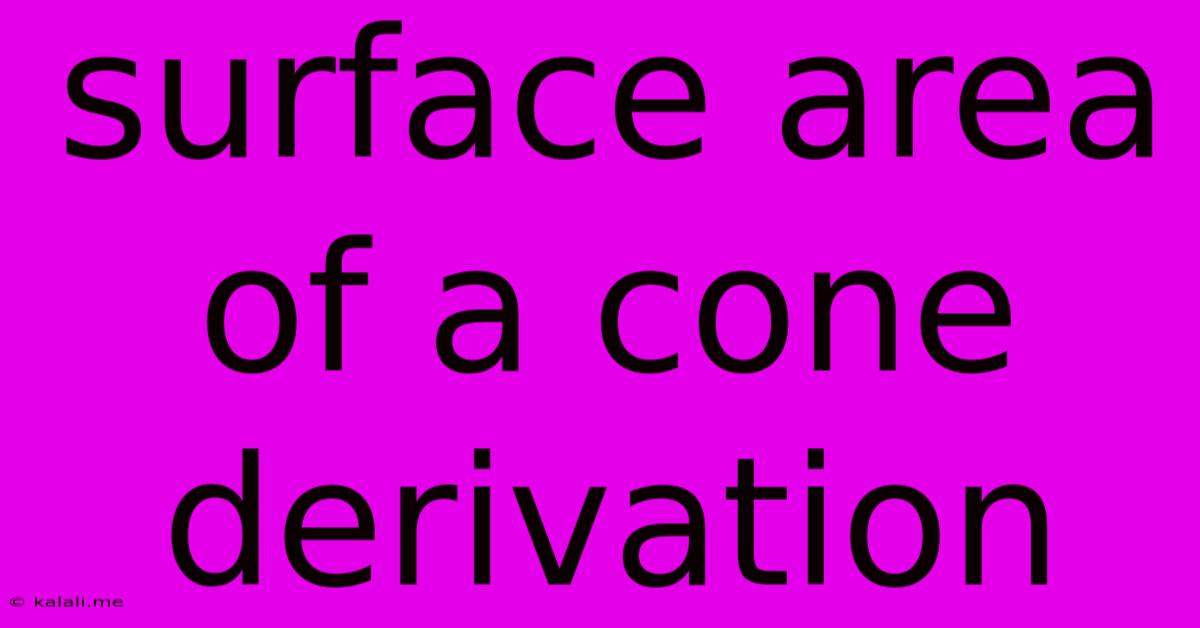Surface Area Of A Cone Derivation
Kalali
Jun 14, 2025 · 3 min read

Table of Contents
Surface Area of a Cone: A Step-by-Step Derivation
Understanding how to calculate the surface area of a cone is crucial in various fields, from engineering and architecture to mathematics and computer graphics. This article provides a clear and concise derivation of the formula, perfect for students and anyone looking to solidify their understanding of this geometrical concept. We'll break down the process into manageable steps, making it easy to follow along. This will cover the lateral surface area and the total surface area.
Understanding the Components: Before we delve into the derivation, let's define the key components of a cone:
- Radius (r): The distance from the center of the circular base to any point on the circumference.
- Slant height (l): The distance from the apex (tip) of the cone to any point on the circumference of the base.
- Height (h): The perpendicular distance from the apex to the center of the base.
These three components are related through the Pythagorean theorem: l² = r² + h².
Deriving the Lateral Surface Area
The lateral surface area of a cone is the curved surface area, excluding the base. Imagine cutting the cone along its slant height and unrolling it. This creates a sector of a circle with radius equal to the slant height (l) of the cone.
-
The Arc Length: The arc length of the sector is equal to the circumference of the cone's base: 2πr.
-
The Sector Area: The area of a sector is given by the formula: (θ/2π) * πl², where θ is the central angle of the sector in radians. Since the arc length is 2πr, we can determine θ using the relationship: θl = 2πr, therefore θ = 2πr/l.
-
Substituting and Simplifying: Substituting the value of θ into the sector area formula, we get:
((2πr/l) / 2π) * πl² = πrl
Therefore, the lateral surface area of a cone is πrl.
Deriving the Total Surface Area
The total surface area of a cone includes both the lateral surface area and the area of the circular base.
-
Area of the Base: The area of the circular base is simply πr².
-
Combining Areas: To find the total surface area, we add the lateral surface area and the base area:
Total Surface Area = Lateral Surface Area + Base Area = πrl + πr²
Therefore, the total surface area of a cone is πr(l + r).
Practical Application and Considerations
This formula is widely used in various applications. For instance, calculating the amount of material needed to construct a conical container or determining the surface area for painting a cone-shaped object. Remember to use consistent units for all measurements (e.g., centimeters, meters) when applying these formulas to ensure accurate calculations. Understanding the derivation helps in applying these formulas correctly and troubleshooting any potential issues. It’s not just about memorizing the formula; it's about understanding the geometrical principles behind it. This understanding allows for a more versatile and effective application of the formula in diverse scenarios.
Latest Posts
Latest Posts
-
First 18 Elements On The Periodic Table
Jun 14, 2025
-
Lcm Of 10 8 And 4
Jun 14, 2025
-
Google Yahoo And Bing Are Examples Of What
Jun 14, 2025
-
How To Write 1150 On A Check
Jun 14, 2025
-
Difference Between Operations Manager And Production Manager
Jun 14, 2025
Related Post
Thank you for visiting our website which covers about Surface Area Of A Cone Derivation . We hope the information provided has been useful to you. Feel free to contact us if you have any questions or need further assistance. See you next time and don't miss to bookmark.